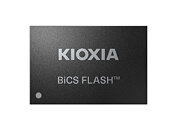- Joined
- Oct 9, 2007
- Messages
- 46,666 (7.66/day)
- Location
- Hyderabad, India
| System Name | RBMK-1000 |
|---|---|
| Processor | AMD Ryzen 7 5700G |
| Motherboard | ASUS ROG Strix B450-E Gaming |
| Cooling | DeepCool Gammax L240 V2 |
| Memory | 2x 8GB G.Skill Sniper X |
| Video Card(s) | Palit GeForce RTX 2080 SUPER GameRock |
| Storage | Western Digital Black NVMe 512GB |
| Display(s) | BenQ 1440p 60 Hz 27-inch |
| Case | Corsair Carbide 100R |
| Audio Device(s) | ASUS SupremeFX S1220A |
| Power Supply | Cooler Master MWE Gold 650W |
| Mouse | ASUS ROG Strix Impact |
| Keyboard | Gamdias Hermes E2 |
| Software | Windows 11 Pro |
KIOXIA America, Inc. has introduced new Industrial Grade flash memory devices. This new lineup utilizes the latest generation KIOXIA BiCS FLASH 3D flash memory with 3-bit-per-cell (triple-level cell, TLC) technology, and is available in a 132-BGA package. Densities range from 512 gigabits (64 gigabytes) to 4 terabits (512 gigabytes) to support the unique requirements of industrial applications - including telecommunication, networking, embedded computing and much more.
The storage requirements for many industrial applications stand in stark contrast to those of SSDs designed to be housed in climate-controlled data centers - including the need for extended temperature ranges and the ability to maintain high reliability and performance in rugged operating conditions. Designed with these needs in mind, the new KIOXIA devices support a wide temperature range (-40°C to +85°C) and offer suitable products for the industrial market.

Due to the fact that flash memory cell performance and reliability improve with a smaller number of bits per cell, the new KIOXIA devices feature 1-bit-per-cell (single-level cell, SLC) mode for applications that require faster read/write times and high cell endurance.
As one of the largest suppliers of flash memory, KIOXIA is committed to supporting multiple industrial grade solutions and accommodating applications that have long life cycles. "The addition of next-generation Industrial Grade BiCS FLASH 3D flash memory continues our commitment to supporting the industrial market segment," said Brian Kumagai, director of business development for KIOXIA America, Inc. "KIOXIA also offers wide temperature range (-40°C to +85°C) low density SLC flash memory solutions designed to support industrial applications."
Sampling of the new KIOXIA Industrial Grade flash memory devices commenced earlier this year, with mass production expected late in the fourth quarter of 2022.
View at TechPowerUp Main Site
The storage requirements for many industrial applications stand in stark contrast to those of SSDs designed to be housed in climate-controlled data centers - including the need for extended temperature ranges and the ability to maintain high reliability and performance in rugged operating conditions. Designed with these needs in mind, the new KIOXIA devices support a wide temperature range (-40°C to +85°C) and offer suitable products for the industrial market.

Due to the fact that flash memory cell performance and reliability improve with a smaller number of bits per cell, the new KIOXIA devices feature 1-bit-per-cell (single-level cell, SLC) mode for applications that require faster read/write times and high cell endurance.
As one of the largest suppliers of flash memory, KIOXIA is committed to supporting multiple industrial grade solutions and accommodating applications that have long life cycles. "The addition of next-generation Industrial Grade BiCS FLASH 3D flash memory continues our commitment to supporting the industrial market segment," said Brian Kumagai, director of business development for KIOXIA America, Inc. "KIOXIA also offers wide temperature range (-40°C to +85°C) low density SLC flash memory solutions designed to support industrial applications."
Sampling of the new KIOXIA Industrial Grade flash memory devices commenced earlier this year, with mass production expected late in the fourth quarter of 2022.
View at TechPowerUp Main Site

